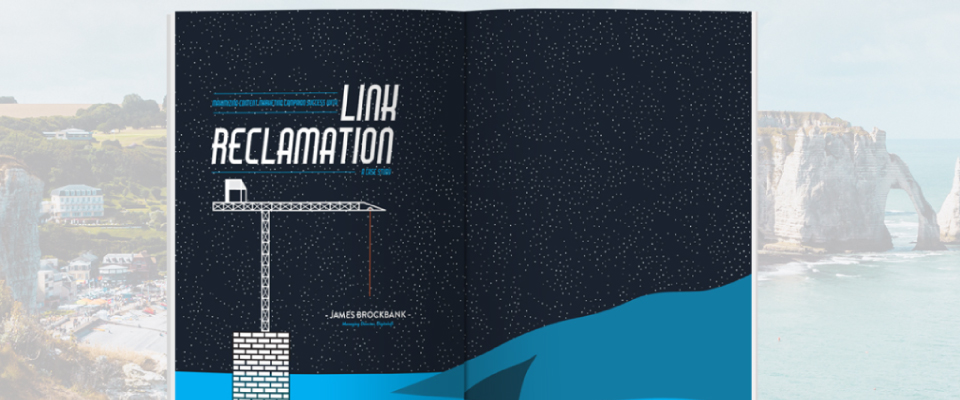
You know the score: you’ve spent hours (or even days) on your latest content marketing campaign. You’ve got a great idea which is backed by great data, and it looks amazing.
You’re busy promoting the campaign, and an email drops into your inbox from a journalist at a top-tier publication. It’s clear that they’ve covered your content and you click through to take a look...
Wait…what?! There’s no link? Only an unlinked brand mention?
This scenario is all too common. Whilst coverage from a top-tier publication isn’t to be frowned upon, don’t forget: there’s more value we can get out of a campaign than brand mentions. A link from an authoritative publication is a powerful signal to search engines, and there’s many a case study to demonstrate this.
At this stage, many simply give up and accept the fact that there’s a brand mention without a link, moving on to further promote the content to other publications with the hope that they’ll provide a valuable link.
You’ve done the hard work though; you’ve created the content and promoted it. The journalist liked the story enough to cover your campaign. What if there was a tried and tested tactic to turn unlinked brand mentions into links within hours of an article going live?
The Problem With Most Link Reclamation Strategies
You’ve probably come across link reclamation before: finding unlinked brand mentions and reaching out to journalists, asking them to add a link to your brand.
The problem with this tactic is the way it’s often executed. In most cases, SEOs and link builders are carrying out link reclamation weeks, or even months, after a mention went live. In many cases, the link builder pursues generic brand mentions where there’s really no real reason for a publisher to link out. After all, you need to remember that journalists don’t have to link.
Asking for a link to your homepage simply because a publication mentioned your brand doesn’t usually add any value to the content. Journalists are smart. Homepage links don’t usually enhance the user experience of their article and in an instance when it does, they’ll likely have already linked.
However, what if you’re asking for links to your relevant content campaign asset? A link which allows a user to explore data or stories covered in the article more in-depth? One which adds value?
Sounds far more appealing to a publication, right?
Why Journalists & Bloggers Link
Journalists don’t link out for the benefit of your SEO campaign. Sorry, but they couldn’t care less how you rank on the SERPs or this month’s link KPIs. They use links to cite sources.
Think back to college; you were likely taught to properly cite your sources and reference where you collected data and information from. Citations add authority to your work, and give due credit to the original author — that same principle applies in online journalism. Links also make it easy to access the original source of information, which can reinforce authority and trust.
When providing a citation, publishers will almost always mention the brand which created the content. After all, if you’ve carried out research and offered a story to a journalist, it’s only right that you should be referenced.
Providing a link, though? Sadly, this doesn’t always happen. Some will always link, others don’t. This doesn’t mean you can’t land a link however, even if an unlinked brand mention has already gone live.
How To Turn Brand Mentions Into Links
There’s a simple process which you can follow to maximize success, which is likely a little different than link reclamation strategies you’ve tried before.
We’ll call it “live link reclamation.”
Why? Because rather than trying to turn old brand mentions from months ago into links, you’ll be doing it within hours of a mention going live. This significantly increases success rates — especially when you add a little trick to maximize your results even further.
It’s a simple 2 step process:
- Discover New Brand Mentions In Real Time
- Reach Out To Publications To Request A Link
It sounds too simple to be effective, doesn’t it?
To explain these two steps further, we’ll use a recent example from a campaign for a client in the travel industry.
The campaign in question was an infographic-led asset which revealed “Europe’s Most Instagrammed Beaches,” and was run by our client, Globehunters. The campaign utilized data about hashtags for every beach in Europe, revealing those which are most popular on the social platform. The story had a hook to international, national, and regional press across Europe and, as you’ll see, initially saw a strong wave of coverage, where over 50% of publishers used unlinked brand mentions rather than links.
How do you identify and turn unlinked brand mentions into links?
Discover New Brand Mentions In Real Time
The key to successful link reclamation is speed. If you can request a link within hours of an article first going live, you’re going to increase your chances of success. Internal data from over 100 link reclamation campaigns ran by Digitaloft over the past 12 months suggests that the success rate almost doubles if you reach out to a publication the same working day of an article being published.
Think on it though. It makes sense. While an article is still fresh, it’s a higher priority for journalists, editors, and the IT team than one that was published months ago.
But how do you find brand mentions so quickly?
Firstly, make sure you set up Google Alerts for every campaign, configured to send ‘as it happens,’ with a source of ‘news,’ and how many set to ‘all results.’ Set up the alert for Brand + “campaign search query.”
Your configured alert should look something like this:
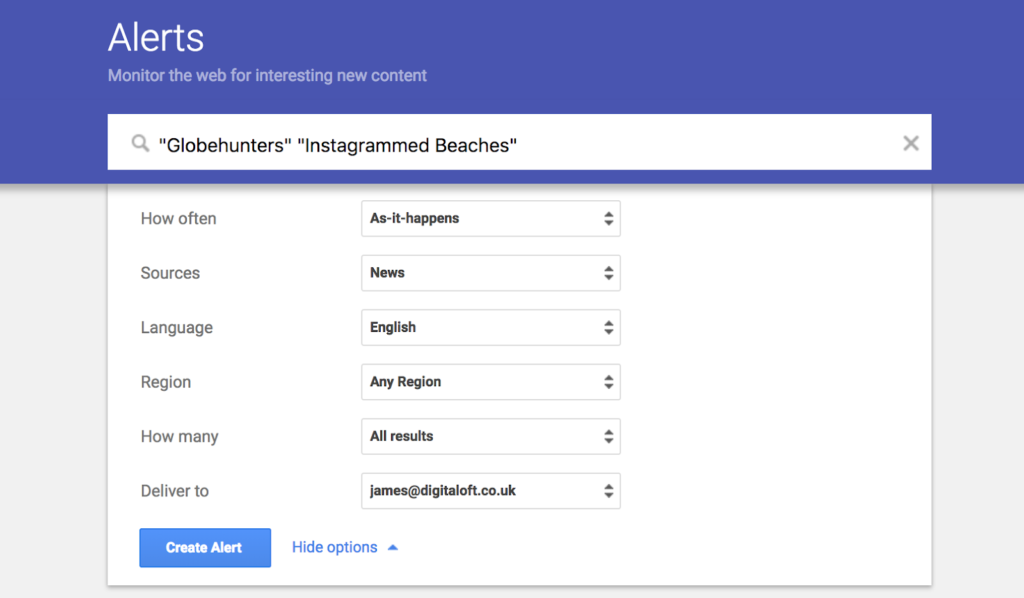
In this case, we set up alerts for:
“Globehunters” + “Instagrammed Beaches”
“Globehunters” + “Instagram”
“Globehunters” + “European Beaches”
“Globehunters” + “Beaches”
We also set up a non-branded alert for “Instagrammed Beaches.”
Setting up alerts for a number of different queries ensures you’re not missing coverage as it happens.
Secondly, keep a browser tab with a Google News search window open, and configure to show results from ‘Past 24 hours.’
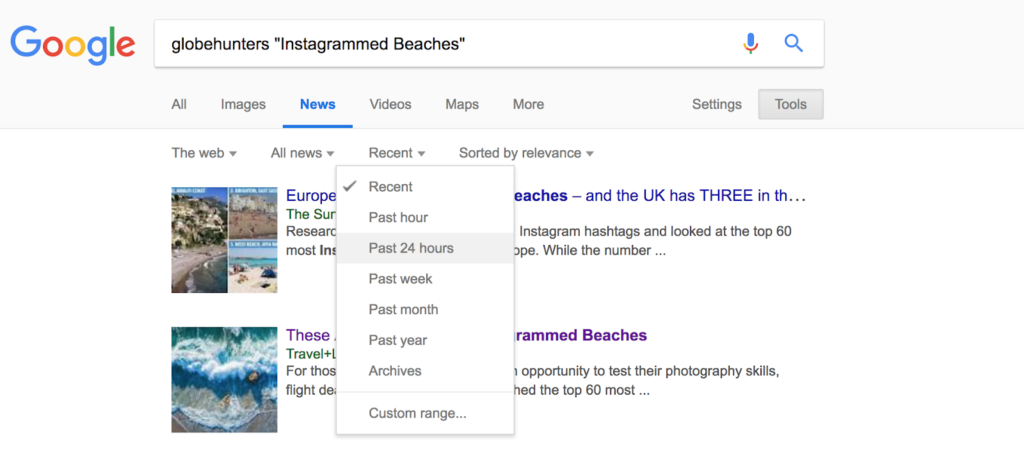
It may sound tedious, but be sure to refresh this page every hour or so while you’re actively outreaching a campaign asset. Once the heavy promotion has stopped, twice a day should suffice until coverage naturally slows down.
With this combined approach, you’re able to pick up coverage within minutes of it being published. You’ll then need to manually check for any unlinked brand mentions. This technique is also perfect for assessing early successes from your campaign.
The best case scenario is that you’ll see all published articles linking. However, the reality is that you’ll quite quickly come across unlinked brand mentions.
Reach Out To Publications To Request A Link
On the Globehunters campaign, we started to see pickup and coverage within 24 hours of beginning the outreach phase.
In fact, the first piece of coverage we landed was iNews, a DA 67 top-tier publication. Here’s the original coverage: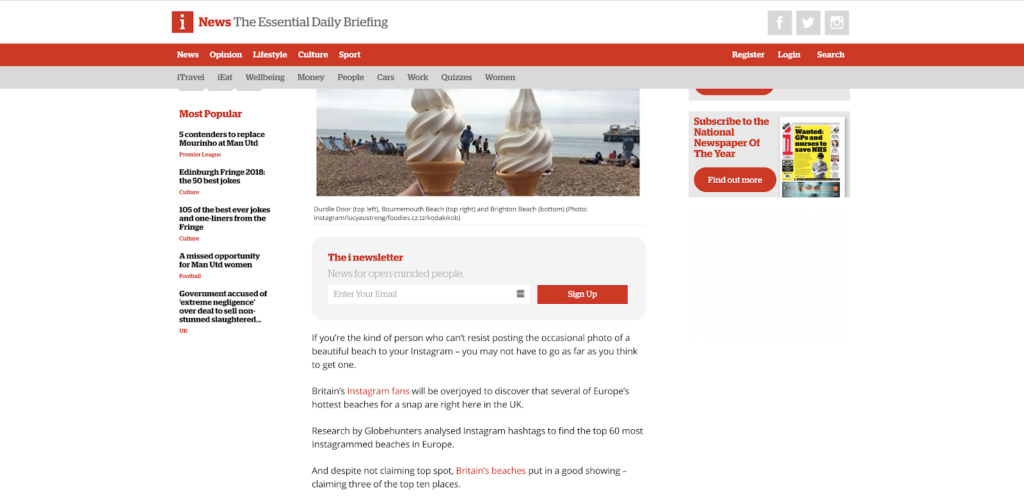 Notice the problem? There’s no link! They have two internal links to other articles on their site, but no link to our client.
Notice the problem? There’s no link! They have two internal links to other articles on their site, but no link to our client.
For reference, the article was published 10:20 A.M. on March 28, 2018. The article was modified later the same day; the modification? A link back to our campaign!
To make this change happen, as soon as we noticed the coverage we immediately jumped on link reclamation, sending the following email to the publication:
28 March 2018 at 15:34
Olivia Smith
Correction: Three of Europe’s top 10 most Instagrammable beaches are here in the UK
To: news@inews.co.uk
Dear News Desk,
I’ve recently seen the iNews article regarding ‘ Three of Europe’s top 10 most Instagrammable beaches are here in the UK,’ it was our client Globehunters that supplied the original research and I just wanted to say thank you for sharing, the article is great.
I just wondered if there was any way you could supply a link to the data within the article, that way anyone reading it can see the original data. It would provide a better reader experience and work as a source for anyone who wants to know more.
Thanks again for sharing!
Best Wishes,
Olivia
A few important notes about this outreach:
We didn’t send it straight back to the journalist. Rather, we sent to the contact listed on the publication’s contact page for corrections. In this case, it was the main news desk. Why? Journalists are busy people and, in many instances, once they’ve hit publish, they’re onto their next assignment. Top-tier publishers typically have IT and corrections teams whose responsibility it is to make amendments and updates. Sending to a main corrections or amends email ensures it’s received by the right people.
We opened the subject with “correction,” as well as immediately including the full article title. The recipient of the email can immediately see, from the subject, that a correction is needed and can forward to the most suitable person to make the edit.
In the main body of the email, we thanked the publication for covering the story. This is key. Remember: a journalist is covering a campaign because they loved the concept, not because they have to. Always begin by saying thank you, not jumping straight in to ask for a link. Manners never hurt anyone!
We then politely asked whether a link could be added in, and showcased that users being able to click through to the data offers a better experience for those who want to explore the topic in more detail. We simply showed how a link would add value.
Within 11 minutes of sending a link reclamation email, we received the following response:
28 March 2018 at 15:45
George Martin
Re: Correction: Three of Europe’s top 10 most Instagrammable beaches are here in the UK
To: Olivia Smith, Cc: Daisy Wyatt
Hi Olivia,
Thanks for getting in touch. I’ve updated the story with a link to the Globehunters data;
https://news.co.uk/inews-lifestyle/travel/europe-instagram-beaches-top-uk/
All the best,
George Martin.
Success!
Today, the article looks like:
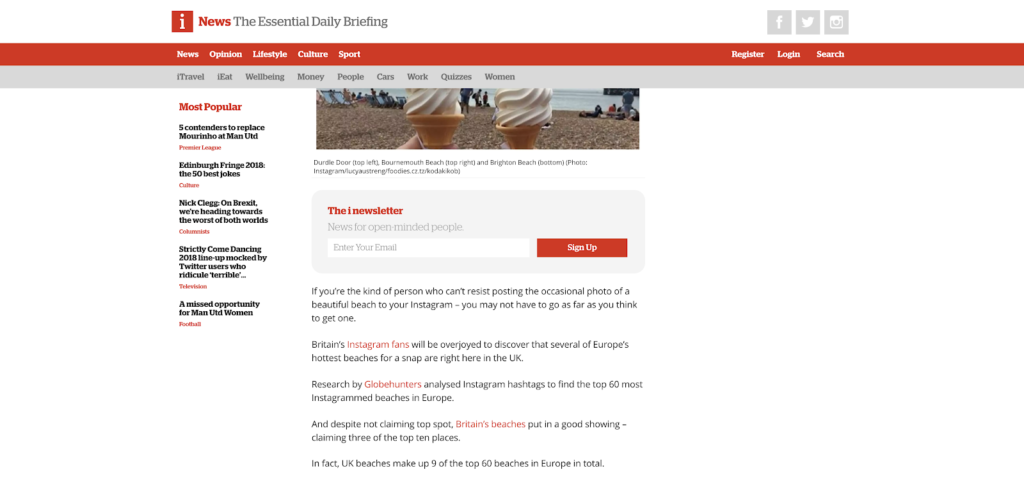
The Campaign Results
To date, the campaign has earned links from publications including Travel & Leisure, The Sun, Country Living, MSN, and Lonely Planet, as well as a wealth of regional publications across Europe including those in Cyprus, Greece, Italy, and Spain.
As an international travel brand, landing links with an international focus has been a key driver of the SEO campaign. However, it’s important to note that not all publications linked to the client at first. Just as we saw above with iNews, we saw over half the coverage (typically that from regional publications) result in unlinked brand mentions. In total, this equated to 18 pieces of coverage.
By utilizing the above link reclamation approach, reaching out within hours of an article being published, we were able to successfully turn 13 of these into links. That’s a success rate of 72%!
The key to successful link reclamation in 2018 is to ensure the link adds value. Demonstrate to a publisher why they should link, and how it will enhance the user experience. Doing so significantly increases results against simply asking for homepage or product and service page links.
Timing is also key. Reaching out to ask for a link to be added into a fresh article (if possible, within hours of it being published) yields a far stronger success rate.
Link reclamation, in many ways, is common sense; think like a journalist and ask yourself what would make them link.
Don’t let your campaign efforts simply return unlinked brand mentions. Have a strategy in place and turn them into links within hours!

